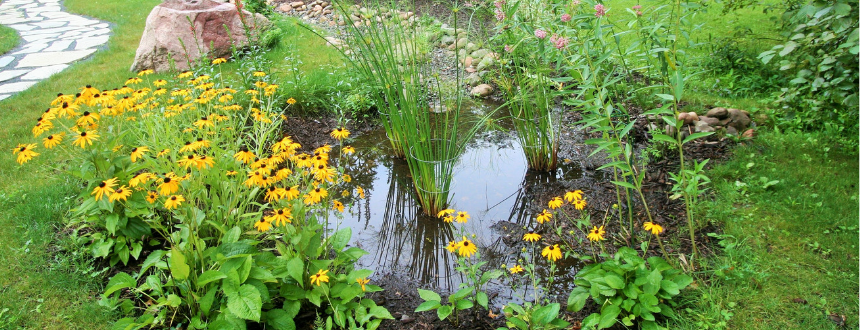
Rain Garden, photo courtesy of Filtrexx
Rain gardens, also called bioretention cells, provide a myriad of benefits including pollutant filtration, flooding prevention, and groundwater recharge. These native plant gardens are located in low-lying areas where stormwater runoff gathers and is naturally filtered, absorbed, and stored by plants and soil.
Since 70 percent of pollution in surface water comes from stormwater, this water filtration is vital to environmental protection. Rich in soil organic material, compost amended soil in the first few inches of topsoil increases soil infiltration, retains more water, and promotes plant growth. Organic rich mulch as a top layer keeps the soil moist and prevents unwanted weed growth.
Rain gardens are great for residential properties but also commercial sites and public spaces. Planted with grasses and flowering perennials, these beautiful landscapes are cost-effective and provide ecosystem benefits.
Where to Use Treatment
Ideally, use treatment in low-lying areas where water naturally drains or is diverted. Since stormwater should soak into the ground within 1 to 3 days, areas where the water table is naturally high, or land is often saturated, is not a good location.
Benefits
- Replenishes groundwater over time
- Reduces property flooding risk
- Creates habitat for butterflies, song birds, and other wildlife
- Naturally filters water and removes pollutants like phosphorus, nitrogen, and hydrocarbons. This prevents contaminated water from entering storm drains and local bodies of water.
- Reduces money spent on irrigating plants
Design Considerations
- Should be located where the garden will receive runoff – check runoff flows and construct diversion measures if necessary
- Natural depression or flat surface makes construction easier
- An area with full or partial sunlight will be more conducive for plant growth
- Avoid large tree roots
- Locate at least 25 feet away from buildings with basements and at least 5 feet away from buildings without
- Locate 5 feet horizontally and 1 foot vertically from any utilities, including water, sewer, and electricity
- Do not build over septic systems
Resources
- More about rain garden benefits and research: USEPA Rain Gardens
- For additional construction and maintenance directions: Potomacriver.org Rain Garden
- For specific California plant recommendations and planting instructions: UCANR Plant Recommendations
- For rain garden basin plant recommendations: Sunset.com Plant Recommendations
- For additional information on rain garden bioretention systems: Filtrexx Rain Garden Bioretention Systems
Research
Dietz, Michael E. and Clausen, John C. A Field Evaluation of Rain Garden Flow and Pollutant Treatment. Water, Air, and Soil Pollution (2005) 167: 123–138. Rain Garden Flow and Pollutant Treatment
Resources
For more information contact: Organic Materials, organics@calrecycle.ca.gov

